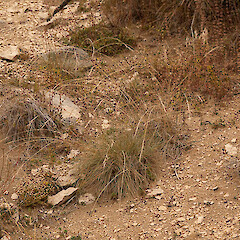Anthosachne falcis
Common name
grass
Synonyms
Elymus falcis Connor
Family
Poaceae
Flora category
Vascular – Native
Endemic taxon
Yes
Endemic genus
No
Endemic family
No
Structural class
Grasses
NVS code
The National Vegetation Survey (NVS) Databank is a physical archive and electronic databank containing records of over 94,000 vegetation survey plots - including data from over 19,000 permanent plots. NVS maintains a standard set of species code abbreviations that correspond to standard scientific plant names from the Ngä Tipu o Aotearoa - New Zealand Plants database.
ANTFAL
Chromosome number
2n = 42
Current conservation status
The conservation status of all known New Zealand vascular plant taxa at the rank of species and below were reassessed in 2017 using the New Zealand Threat Classification System (NZTCS) – more information about this can be found on the NZTCS website. This report includes a statistical summary and brief notes on changes since 2012 and replaces all previous NZTCS lists for vascular plants.
Please note, threat classifications are often suggested by authors when publications fall between NZTCS assessment periods – an interim threat classification status has not been assessed by the NZTCS panel.
- Conservation status of New Zealand indigenous vascular plants, 2017 . 2018. Peter J. de Lange, Jeremy R. Rolfe, John W. Barkla, Shannel P. Courtney, Paul D. Champion, Leon R. Perrie, Sarah M. Beadel, Kerry A. Ford, Ilse Breitwieser, Ines Schönberger, Rowan Hindmarsh-Walls, Peter B. Heenan and Kate Ladley. Department of Conservation. Source: NZTCS and licensed by DOC for reuse under the Creative Commons Attribution 4.0 International licence.
2017 | At Risk – Declining | Qualifiers: DP, Sp
Previous conservation statuses
2012 | At Risk – Naturally Uncommon | Qualifiers: Sp
2009 | At Risk – Naturally Uncommon | Qualifiers: Sickle-leaved wheatgrass
2004 | Range Restricted
Distribution
Endemic. New Zealand: South Island (inland Waimakariri, Ashburton, Waitaki and Central Otago). Populations usually scattered.
Habitat
Dry open ground, river beds, rocky sites, clay pans and within short tussock (Festuca novae-zelandiae) grassland from 450–1250 m a.s.l.
Detailed description
Small, glaucous, loosely tufted grass. Leaf-sheath 20–50 mm, striate, retrorsely pubescent or glabrous. Ligule 0.3–0.5 mm, erose or finely toothed. Leaf-blade 50–150 × 0.5–0.7 mm, terete, involute, keeled and faintly ribbed, falcate, sinuous or irregularly curled, rarely straight, upper surface glaucous, with stiff erect, retrorse hairs 0.5–1 mm long, becoming glabrous, undersides densely hairy, lamina margin prickle-toothed, or with hairs 0.5 mm long. Culms 100–250 mm, prostrate to ascending, internodes smooth, glaucous. Inflorescences 20–100 mm, of 1–4 spikelets. Spikelets 40–50 mm, each with 4–6 shining florets. Glumes ± equal, 4–9 mm, keeled, 3-nerved, becoming awned, glabrous, margins papery. Lemma smooth except for prickle-teeth on keel above, extending into falcate awn 30–50 mm. Palea 7–10 mm, apex pointed, bifid. Rachilla 1.5–2 mm, short stiff hairy. Callus 0.75 mm, very shortly bearded, hairs less than or equal in length to callus. Anthers 2.5 mm yellow (purple in some plants).
Manaaki Whenua Online Interactive Key
Similar taxa
Perhaps closest to Anthosachne sacandros, from which it differs by the short, falcate, sinuous or straight leaf-blades, which are glabrous or with scattered erect 1 mm long hairs, and prostrate to ascending culms. Recognition in field: small glaucous tufts with flower stems extending well above leaf tip. Similar to A. aprica (which is a larger plant, with more spikes held at a distinct angle in the inflorescence) or the exotic A. scabra (which is similar in size, but the leaves are flat, hairy, and with distinct auricles at the base). This species was transferred from Elymus to Anthosachne by Barksworth & Jacobs (2011).
Flowering
October–February
Flower colours
Violet/Purple, Yellow
Fruiting
November–March
Life cycle
Florets are dispersed by wind and attachment (Thorsen et al., 2009).
Propagation technique
Easy from fresh seed. Does best in dry climates. Prefers a sunny situation free of weeds. In strong sunlight the leaves often become very glaucous.
Threats
A local endemic of restricted distribution that while not believed to be threatened occupies a very narrowly defined range that is ever increasingly vulnerable to loss of habitat through the expansion of the wine industry in Central Otago and the increasing urbanisation of the Waitaki and McKenzie Basins.
Where to Buy
Not commercirally available
Attribution
Fact sheet prepared for NZPCN by P. J de Lange, June 2005. Description adapted from Edgar & Connor (2000).
References and further reading
Barkworth ME, Jacobs SWL. 2011: The Triticeae (Gramineae) in Australasia. Telopea 13: 37–56.
Edgar E, Connor HE. 2000. Flora of New Zealand. Vol. V. Grasses. Christchurch, Manaaki Whenua Press. 650 p.
Thorsen MJ, Dickinson KJM, Seddon PJ. 2009. Seed dispersal systems in the New Zealand flora. Perspectives in Plant Ecology, Evolution and Systematics 11: 285–309. https://doi.org/10.1016/j.ppees.2009.06.001.
NZPCN Fact Sheet citation
Please cite as: de Lange, P.J. (Year at time of access): Anthosachne falcis Fact Sheet (content continuously updated). New Zealand Plant Conservation Network. https://www.nzpcn.org.nz/flora/species/anthosachne-falcis/ (Date website was queried)








